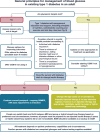The management of type 1 diabetes in adults. A consensus report by the American Diabetes Association (ADA) and the European Association for the Study of Diabetes (EASD)
- PMID: 34590174
- PMCID: PMC8481000
- DOI: 10.1007/s00125-021-05568-3
The management of type 1 diabetes in adults. A consensus report by the American Diabetes Association (ADA) and the European Association for the Study of Diabetes (EASD)
Erratum in
-
Correction to: The management of type 1 diabetes in adults. A consensus report by the American Diabetes Association (ADA) and the European Association for the Study of Diabetes (EASD).Diabetologia. 2022 Jan;65(1):255. doi: 10.1007/s00125-021-05600-6. Diabetologia. 2022. PMID: 34851428 Free PMC article.
Abstract
The American Diabetes Association (ADA) and the European Association for the Study of Diabetes (EASD) convened a writing group to develop a consensus statement on the management of type 1 diabetes in adults. The writing group has considered the rapid development of new treatments and technologies and addressed the following topics: diagnosis, aims of management, schedule of care, diabetes self-management education and support, glucose monitoring, insulin therapy, hypoglycaemia, behavioural considerations, psychosocial care, diabetic ketoacidosis, pancreas and islet transplantation, adjunctive therapies, special populations, inpatient management and future perspectives. Although we discuss the schedule for follow-up examinations and testing, we have not included the evaluation and treatment of the chronic microvascular and macrovascular complications of diabetes as these are well-reviewed and discussed elsewhere. The writing group was aware of both national and international guidance on type 1 diabetes and did not seek to replicate this but rather aimed to highlight the major areas that healthcare professionals should consider when managing adults with type 1 diabetes. Though evidence-based where possible, the recommendations in the report represent the consensus opinion of the authors. Graphical abstract.
Keywords: Adjunctive therapy; Diabetic ketoacidosis; Diagnosis; Exercise; Glucose monitoring; Hypoglycaemia; Insulin; Nutrition; Psychosocial care; Schedule of care; Transplantation; Type 1 diabetes.
© 2021. European Association for the Study of Diabetes and American Diabetes Association.
Figures







References
Publication types
MeSH terms
Substances
LinkOut - more resources
Full Text Sources
Medical
Research Materials

